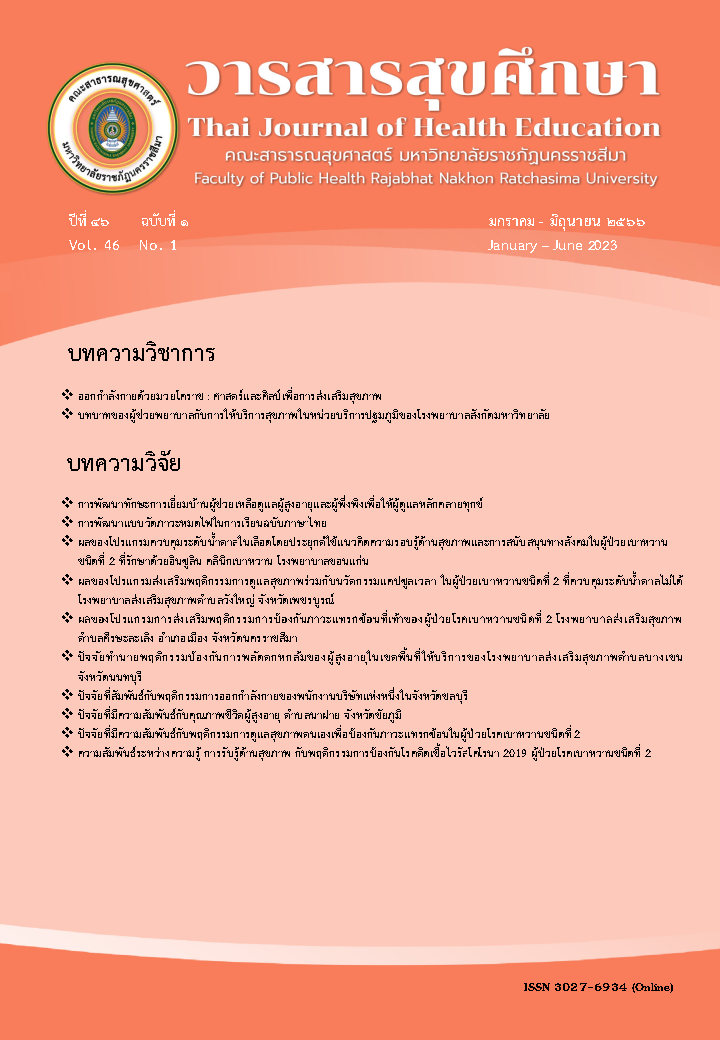Development of the Academic Burnout Scale (Thai Version)
Main Article Content
Abstract
Academic burnout is a state that undergraduate students commonly experience. This is caused by the accumulation of stress related to their studies and situations that have occurred. Academic burnout is related to negative consequences in various aspects of a student's life. Therefore, prioritizing research and assessing academic burnout are crucial. The purpose of this study is to develop and review the quality of the Academic Burnout Scale (Thai Version). The researcher developed the scale and distributed it to three experts for content validity testing through an IOC investigation. Afterwards, data was collected from 168 undergraduate students between the ages of 18 and 25 using convenience and snowball sampling methods. Subsequently, the researcher utilized the collected data to investigate the scale's reliability by calculating Cronbach's alpha coefficient and examine its construct validity through Second Order Confirmatory Factor Analysis.
The results of the study indicated that the Academic Burnout Scale, consisting of 20 items, has internal consistency with a Cronbach's alpha coefficient of .93. The scale was composed of three dimensions: emotional exhaustion, cynicism, and inefficacy, each comprising 8, 7, and 5 items, respectively. The factor loadings for each dimension ranged from .37 to .94 for emotional exhaustion, .53 to .88 for cynicism, and .69 to .85 for inefficacy. Additionally, the academic burnout model demonstrated consistency with empirical data, as indicated by χ² = 142.44, df = 121, RMSEA = .03, SRMR = .06, and CFI = .99. Therefore, the Academic Burnout Scale (Thai Version) was found to possess both reliability and validity and can be used to assess academic burnout among undergraduate students.
Article Details

This work is licensed under a Creative Commons Attribution-NonCommercial-NoDerivatives 4.0 International License.
References
กรุงเทพธุรกิจ. ‘เรียนออนไลน์’ กับ 7 ปัญหาสุขภาพที่เด็กไทยต้องเจอแก้ยังไงดี 2021, August 27 [Available from:
https://www.bangkokbiznews.com/news/957001
Bresó E, Salanova, M., & Schaufeli, W. B. In search of the “third dimension” of burnout: Efficacy or inefficacy? Applied
Psychology. 2007;56(3):460-78.
Chula Student Wellness. เพราะเรื่องสุขภาพใจเป็นเรื่องใกล้ตัวของเราทุกคน. 2022.
Hair JF, Black, W.C., Babin, B.J. & Anderson, R.E. Multivariate Data Analysis. 7th ed: Pearson: New York; 2010.
Kim B, Lee, M., Kim, K., Choi, H., & Lee, S. M. Longitudinal analysis of academic burnout in Korean middle school
students. Stress and Health. 2015;31(4):281-9.
Kiuru N, Aunola, K., Nurmi, J. E., Leskinen, E., & Salmela-Aro, K. Peer group influence and selection in adolescents' s
chool burnout: A longitudinal study. Merrill-Palmer Quarterly. 2008;54(1): 23-55.
Kyeong LW. Self-compassion as a moderator of the relationship between academic burn-out and psychological health
in Korean cyber university students. Personality and Individual Differences. 2013;54(8):899-902.
Lee M, Lee, K. J., Lee, S. M., & Cho, S. . From emotional exhaustion to cynicism in academic burnout among Korean
high school students: Focusing on the mediation effects of hatred of academic work. Stress and Health.
;36(3):376-83.
Lee MY, & Lee, S. M. . The effects of psychological maladjustments on predicting developmental trajectories of
academic burnout. School Psychology International. 2018;39(3):217-33.
Lin SH, & Huang, Y. C. . Life stress and academic burnout. Active Learning in Higher Education. 2014;15(1):77-90.
Madigan DJ, & Curran, T. Does burnout affect academic achievement? A meta-analysis of over 100,000 students.
Educational Psychology Review. 2021;33(2):387-405.
Mokgele KR, & Rothmann, S. A structural model of student well-being. South African Journal of Psychology.
;44(4):514-27.
Mostert K, & Pienaar, J. The moderating effect of social support on the relationship between burnout, intention to
drop out, and satisfaction with studies of first-year university students. Journal of Psychology in Africa.
;30(3):197-202.
Pulido‐Martos M, Augusto‐Landa, J. M., & Lopez‐Zafra, E. Sources of stress in nursing students: a systematic review
of quantitative studies. International Nursing Review. 2012;59(1):15-25.
Salmela-Aro K, Kiuru, N., Pietikäinen, M., & Jokela, J. Does school matter? The role of school context in adolescents'
school-related burnout. European Psychologist. 2008;13(1):12-23.
Salmela-Aro K, Kiuru, N., Leskinen, E., & Nurmi, J. E. School burnout inventory (SBI) reliability and validity. European
Journal of Psychological Assessment. 2009;25(1):48-57.
Schaufeli WB, Salanova, M., González-Romá, V., & Bakker, A. B. The measurement of engagement and burnout: A
two sample confirmatory factor analytic approach. Journal of Happiness Studies. 2002;3(1):71-92.
Shin H, Lee, J., Kim, B., & Lee, S. M. Students’ perceptions of parental bonding styles and their academic burnout.
Asia Pacific Education Review. 2012;13(3):509-17.
TAŞÖREN AB, & BURHAN, S. The role of emotional distress in the relationship between COVID-19 burnout and
academic burnout in university students. OPUS Journal of Society Research. 2022;19(46):340-53.
Wu H, Li, S., Zheng, J., & Guo, J. Medical students’ motivation and academic performance: the mediating roles of
self-efficacy and learning engagement. Medical Education Online. 2020;25(1):1742964.
Xie YJ, Cao, D. P., Sun, T., & Yang, L. B. The effects of academic adaptability on academic burnout, immersion in
learning, and academic performance among Chinese medical students: a cross-sectional study. BMC Medical Education. 2019;19(1):1-8.
Yang HJ. Factors affecting student burnout and academic achievement in multiple enrollment programs in
Taiwan’s technical–vocational colleges. International Journal of Educational Development. 2004;24(3):283-301.
ธมยันตี ประยูรพันธ์. การทดสอบโมเดลสมการโครงสร้างความพึงพอใจในการปฏิบัติงาน พฤติกรรมการเป็นสมาชิกที่ดีขององค์กร และ
พฤติกรรมการทําางานเชิงนวัตกรรมของพนักงานองค์กรวิสาหกิจขนาดกลางและขนาดย่อมในจังหวัดชายแดนใต้. วารสาร
มหาวิทยาลัยนราธิวาสราชนครินทร์ สาขามนุษยศาสตร์และสังคมศาสตร์. 2561;5(2):55-73.


